
Henri Matisse: Invitation to the Voyage at Fondation Beyeler, Basel
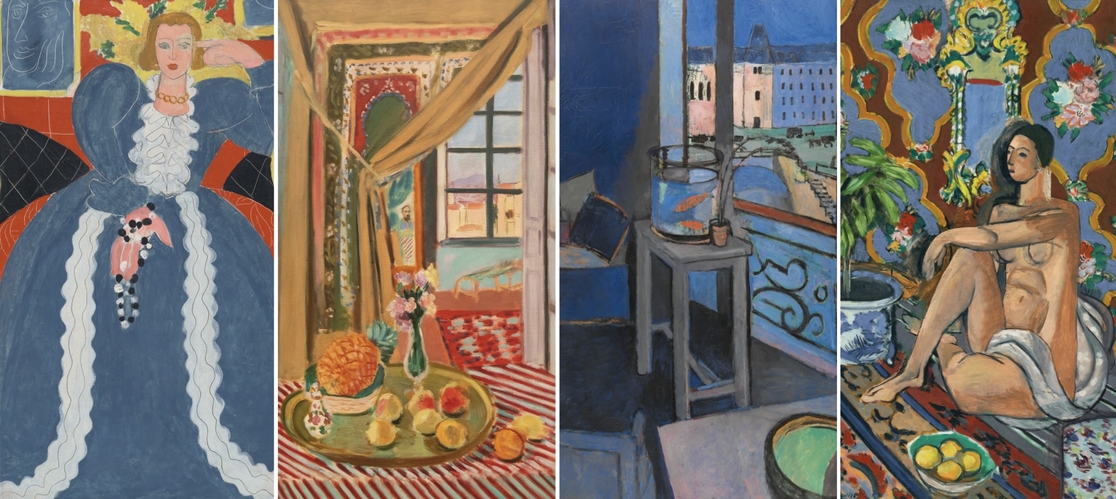
From September 2024 to the end ofJanuary 2025, the Fondation Beyeler in Riehen/Basel, Switzerland, invites visitors to embark on a journey through the life and work of Henri Matisse, one of the most influential artists of the 20th century. The exhibition Matisse – Invitation to the Voyage marks the first major retrospective dedicated to the artist in Switzerland and the German-speaking world in nearly twenty years. Curated by Raphaël Bouvier, the show brings together over 70 works by Henri Matisse, on loan from renowned institutions such as the MoMA in New York and the Centre Pompidou in Paris, as well as private collections. With this comprehensive selection, the exhibition offers a complete portrait of Matisse’s trajectory, revealing the evolution of his style, his innovations, and the depth of his artistic process.
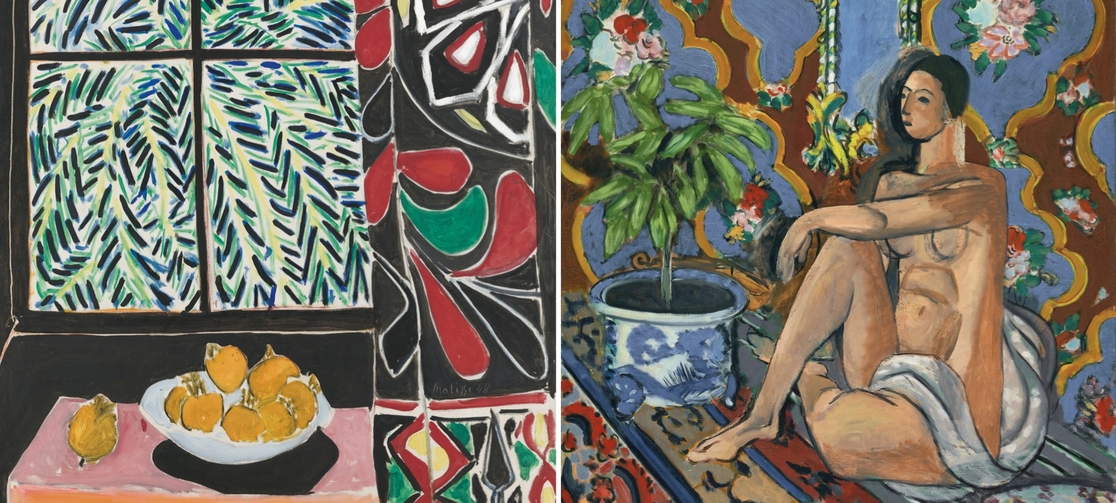
LEFT: Henri Matisse, Intérieur au rideau égyptien (Interior with an Egyptian Curtain), 1948, Oil on canvas, 116.2 x 89.2 cm. The Phillips Collection, Washington, DC, acquired 1950, © Succession H. Matisse / 2024, ProLitteris, Zurich. Photo: The Phillips Collection, Washington, D.C.; RIGHT: Henri Matisse, Figure décorative sur fond ornemental (Decorative Figure on an Ornamental Ground), 1925/26, Oil on canvas, 130 x 98 cm. Musée national d’art moderne, Centre Pompidou, Paris, state purchase 1938. © Succession H. Matisse / 2024, ProLitteris, Zurich. Photo: © Centre Pompidou, MNAM-CCI, Dist. RMN-Grand Palais / Philippe Migeat
Henri Matisse (1869–1954) was one of the most important artists of the 20th century, renowned for his innovative use of color and the elegant simplicity of his forms. Born in northern France, Matisse initially studied law, but after discovering painting, he devoted himself entirely to art. He revolutionized modern painting by freeing color from its representational functions, exploring it as a pure expression of emotion.
Baudeleire and Matisse
Inspired by Charles Baudelaire’s celebrated poem “Invitation to the Voyage”, the exhibition delves into essential themes that permeate Matisse’s work: the pursuit of beauty, serenity, and pleasure—captured in the expression “luxe, calme et volupté” (luxury, calm, and pleasure), borrowed from the poem and embodying the essence of Matisse’s vision of art. Like Baudelaire, who used poetry to construct an ideal universe, Matisse creates in his canvases a vibrant and luminous world, where the harmony of forms intertwines with bold creative freedom, offering the public an almost lyrical and poetic experience.
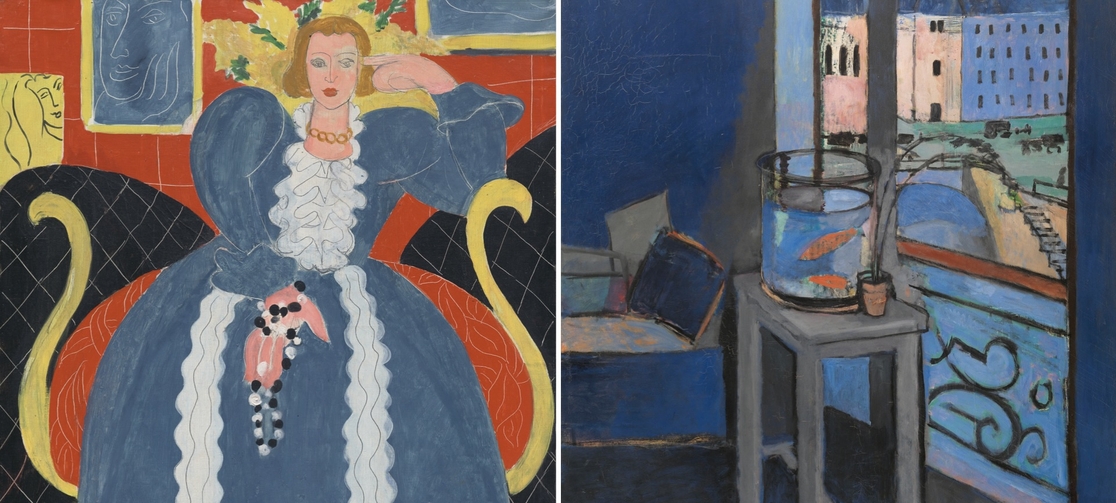
LEFT: Henri Matisse, La grande robe bleue et mimosas (The Large Blue Robe and Mimosas), 1937, Oil on canvas, 92.7 x 73.7 cm, Philadelphia Museum of Art, gift of Mrs. John Wintersteen, 1956. © Succession H. Matisse / 2024, ProLitteris, Zurich. Photo: Philadelphia Museum of Art; RIGHT: Henri Matisse, Intérieur, bocal de poissons rouges (Interior with a Goldfish Bowl), 1914 Oil on canvas, 147 x 97 cm. Musée national d’art moderne, Centre Pompidou, Paris, bequest of Baronne Eva Gourgaud, 1965, © Succession H. Matisse / 2024, ProLitteris, Zurich. Photo: © Centre Pompidou, MNAM-CCI, Dist. RMN-Grand Palais / Philippe Migeatigeat
The Ideal Light
For Matisse, art was inseparable from the concept of travel. From a young age, he journeyed in search of the “ideal light,” which he believed captured the subtlest nuances of nature and humanity. Initially, he found this light in southern France, where the Mediterranean sun inspired him to use vibrant colors and loose brushstrokes, leading to one of his most revolutionary periods: Fauvism.
Moreover, Matisse reduced bodily forms to simplified lines and volumes, eliminating superfluous details. This gave the bodies a more robust and essential appearance, focusing on expression and posture. The absence of shadows or color gradations made the figures flatter, yet they gained a striking presence through dynamic compositions and the use of contrasting colors.
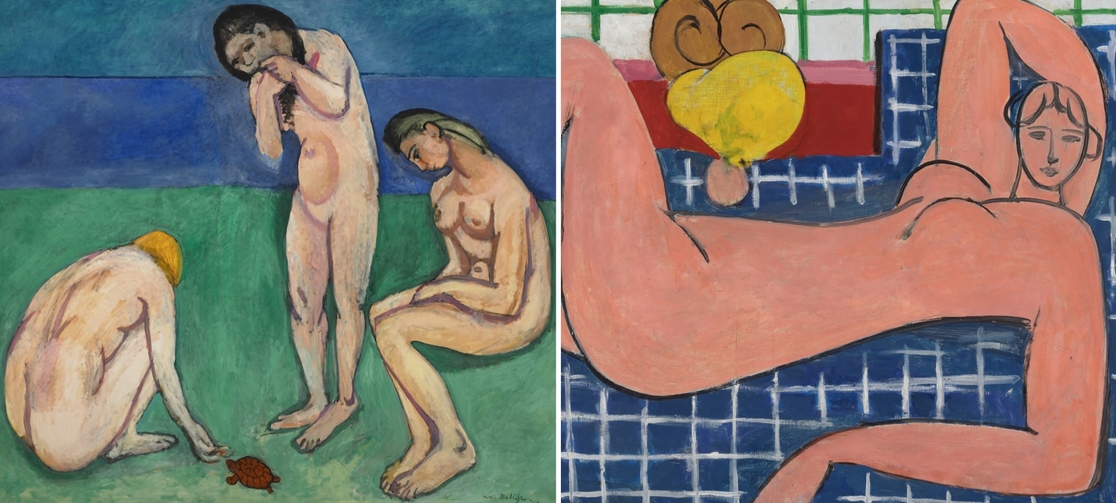
LEFT: Henri Matisse, Baigneuses à la tortue (Bathers with a Turtle), 1907-08, Oil on canvas, 181.6 x 221 cm, Saint Louis Art Museum, gift of Mr. and Mrs. Joseph Pulitzer Jr. © Succession H. Matisse / 2024, ProLitteris, Zurich. Photo: Saint Louis Art Museum; RIGHT: Henri Matisse, Grand nu couché (Nu rose) [Large Reclining Nude (The Pink Nude)], 1935 Oil on canvas, 66.4 x 93.3 cm. The Baltimore Museum of Art, The Cone Collection, formed by Dr. Claribel Cone and Etta Cone of Baltimore, Maryland, 1950, © Succession H. Matisse / 2024, ProLitteris, Zurich. Photo: Mitro Hood
Matisse’s search for light also led him to explore locations such as North Africa, Spain, and the South Pacific, where he encountered a rich cultural diversity that he would integrate into his work. Each journey brought new discoveries that he incorporated into his art, creating a universe where cultures, colors, and forms fused together. In the exhibition, historical photographs and films transport visitors to these exotic landscapes, revealing the profound connection between the artist and the environments that shaped his artistic vision.
A Symbol of Freedom
One recurring element in Matisse’s work is the open window, which appears in several of his paintings as a symbol of transition and openness to the world. The window represents the connection between the interior and exterior, between the artist’s studio and the vibrant world beyond. In works like “La fenêtre ouverte” (1905), Matisse uses the window as a portal to the unknown, an implicit invitation for the viewer to experience life beyond boundaries. This motif reflects Matisse’s relentless quest for freedom and creative renewal, as if each painting offered a new perspective, a fresh vision of the world.
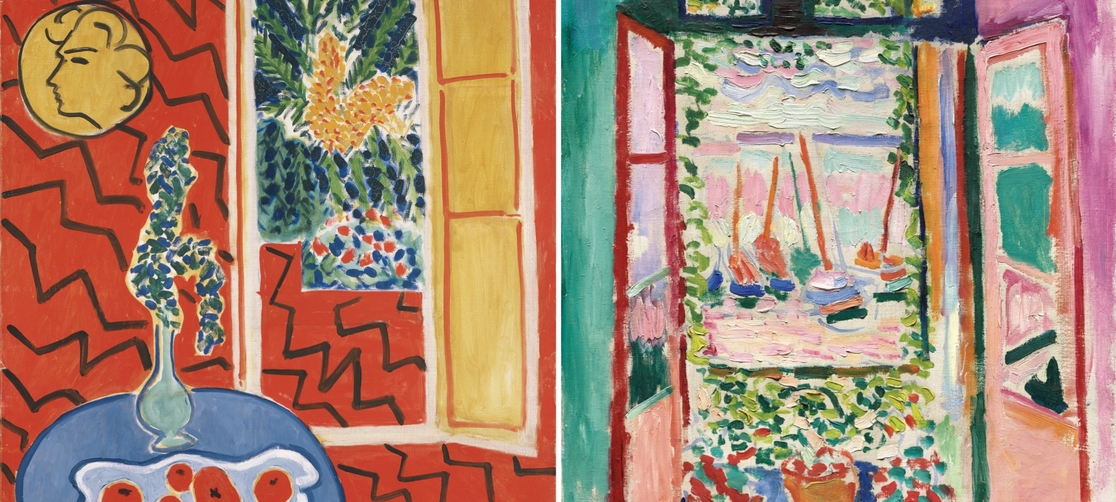
LEFT: Henri Matisse, Intérieur rouge, nature morte sur table bleue (Red Interior: Still Life on a Blue Table), 1947, Oil on canvas, 116 x 89 cm. Kunstsammlung Nordrhein-Westfalen, Düsseldorf, purchased 1964 from a donation by Westdeutscher Rundfunk. © Succession H. Matisse / 2024, ProLitteris, Zurich. Photo: bpk / Kunstsammlung Nordrhein-Westfalen, Düsseldorf / Walter Klein; RIGHT: Henri Matisse, La fenêtre ouverte, Collioure (The Open Window), 1905, Oil on canvas, 55.3 x 46 cm National Gallery of Art, Washington, DC, collection of Mr. and Mrs. John Hay Whitney, 1998, © Succession H. Matisse / 2024, ProLitteris, Zurich. Photo: Courtesy National Gallery of Art, Washington
From Fauvism to Collages
The exhibition “Matisse – Invitation to the Voyage” also traces Matisse’s stylistic journey, from Fauvism with its revolutionary use of color to the vibrant collages of his later years. Over time, Matisse increasingly simplified the forms in his paintings, developing a visual language that became synonymous with modernity. His collages, such as the iconic “Nu bleu I” (1952), are a celebration of simplicity and the power of pure form. They represent the pinnacle of Matisse’s artistic experimentation, where he achieved a perfect balance between drawing, painting, and sculpture.

LEFT: Henri Matisse, Nu bleu aux bas verts (Blue Nude with Green Stockings), 1952, Gouache on paper, cut and pasted, on paper on canvas, 258 x 167 cm. Fondation Louis Vuitton, Paris, © Succession H. Matisse / 2024, ProLitteris, Zurich. Photo: © Primae / Louis Bourjac; RIGHT: Henri Matisse, Composition à la croix rouge (Composition with Red Cross), 1947, Gouache on paper, cut and pasted, on paper, 74 x 52.4 cm. Private collection, © Succession H. Matisse / 2024, ProLitteris, Zurich, Photo: Robert Bayer
Reinterpretations and Matisse’s Legacy in Modern Art
Matisse’s ability to challenge conventions and create his own artistic language had a lasting impact on modern art. By transforming color into an independent element and exploring the freedom of form, Matisse anticipated movements such as Abstract Art and Pop Art. His pursuit of an aesthetic that was both simple and powerful changed how art is understood and experienced.
Henri Matisse: Invitation to the Voyage, the exhibition at the Fondation Beyeler, invites the public to immerse themselves in the complexity of Matisse’s artistic journey, where each painting, sculpture, and collage expresses an explosion of identity and color. Matisse reminds us that art can be a refuge of serenity and beauty, a space where life is reimagined with luxury and calm. For Matisse, the world was a blank canvas, and he filled it with a unique intensity and lightness, inspiring us to look beyond the windows of everyday life and embark on an unforgettable journey through his work.
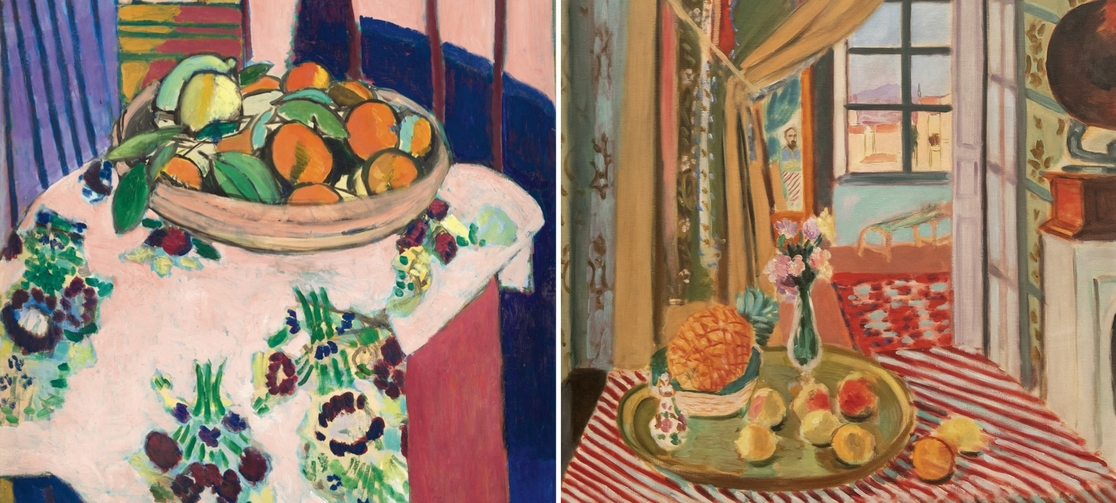
LEFT: Henri Matisse, Nature morte aux oranges (Still Life with Oranges), 1912, Oil on canvas, 95 × 84,8 cm. Musée national Picasso-Paris, donation Picasso, 1978, © Succession H. Matisse / 2024, ProLitteris, Zürich. Photo: © RMN-Grand Palais (Musée national Picasso-Paris) / Mathieu Rabeau; RIGHT: Henri Matisse, Intérieur au phonographe (Interior with a Phonograph), 1924, Oil on canvas, 100.5 x 80 cm. Pinacoteca Agnelli, Turin, © Succession H. Matisse / 2024, ProLitteris, Zurich. Photo: Pinacoteca Giovanni e Marella Agnelli, Turin
LOT-ART SERVICES FOR COLLECTOR
NEW! Best Deals: Bid on highly liquid lots with an estimate below the historical sale price. Make smart investment decisions powered by Market Analytics. Discover Best Deals >>
Market Analytics: Lot-Art big data analytics assess the liquidity, actual value, investment risk and profitability of fine art (contemporary art, modern art, old masters) and luxury collectibles (timepieces), enabling informed investment decisions within a strategy of portfolio diversification. Discover Market Analytics >>
Lot-Art Memberships: Receive Personalized Alerts on your favorite artists and collectibles at auction worldwide to never miss a bid! Subscribe now >>
Lot-Art.com is the world's largest search engine & aggregator of art and collectibles linking to 3800+ auction houses! Find best deals from your favorite artists and brands among 1 million lots for sale every day in our upcoming section >>
LOT-ART | The Art Investment Platform
Lot-Art.com is the largest search engine & aggregator for auctions of art and collectibles linking to 3800+ auction houses! Find best deals from your favorite artists and brands among 1 million lots for sale every day in our upcoming section.
LOT-ART | The Art Investment Platform
contact@lot-art.com
|
|
|
|
|---|
Don't want these emails anymore? |
|
|
|---|
|